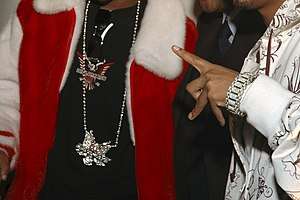Bling-bling
Bling-bling, often shortened to just bling, is "flashy jewelry worn especially as an indication of wealth or status; broadly: expensive and ostentatious possessions"[1] such as grills and designer bags. The term arose as localized slang, but grew into a cultural mainstay. Although the term's history is somewhat contested, it is primarily attributed to roughly 1998 when New Orleans rapper Baby Gangsta[2] wanted to encapsulate "the imaginary sound that light makes when it hits a diamond."[3] Nevertheless, some people have attributed bling's name to either other earlier rappers or to the old cartoonish sound effects meant to convey the desirability and or shininess of gold, gems, jewels, money, and more. Undeniably, though, bling became increasingly entrenched within the hip hop movement following Baby Gangsta's release of his lead single "Bling Bling" off of his 1999 album Chopper City in the Ghetto.

Origins and popularization of the term
In linguistics terms, bling is either an ideophone or an onomatopoeia, depending on the definition one uses, with bling-bling being its reduplication. It is important to note that some people have attributed the term to rappers that came before B.G., or to the old cartoonish sound effects meant to convey the desirability and or shininess of gold, gems, jewels, money, and more.

In that light, during the mid-to-late 1960s, toothpaste maker Ultra Brite ran a series of commercials stating "Ultra Brite gives your mouth...[blown kiss]...[bell ting]...sex appeal!" suggesting fresh breath and a brilliant smile.[4][5] Before the words "sex appeal", a bell sound effect played in the background as a young man or woman smiled. Comedians such as Martin Lawrence parodied the "Ultrabrite smile" sequence [blow] + [ting] "bling" as both "bling-bling," and "bling-blauw."
Similarly, in the section of the music industry devoted to composing movie and television audio and soundtracks, musicians and producers often used a glockenspiel to signify the "bling" sound. More specifically, they played a single note in one of many broken octaves as a musical translation of the visual effect of the glint of light on a gem or piece of jewelry. Consequently, TV and movie producers employed the method outlined above a little too often, especially in low budget TV cartoons. The 'B-' of the 'Bling' mimics the lower octave chime, while the '-ling’ similarly vocalizes the lighter and less percussive sound of the same note played an octave (or two) higher, struck just a millisecond later.[6] Alternatively, they used (and still use) various types of hand bells to make the iconic sound.
In terms of using "bling" explicitly to refer to ostentatious jewelry, one of the first real usages came from the hit TV show Martin. Martin Lawrence, playing the role of "Jerome," characteristically "sport[ed] a family-heirloom 'gold toof-es' in his mouth," along with other jewelry that mirrors what pimps were wearing at the time. Less-known, and seemingly not a reference to jewelry, Dana Dane also used the word bling in his 1987 song "Nightmares." Alternatively, Jesse West, better known by the stage-name 3rd Eye, is cited as perhaps the first rapper to use the term "bling bling" as we know it on the "Bad Boy Extended Mix" to Super Cat's 1993 hit "Dolly My Baby."[7] West opens his verse by saying, "bling bling. Who's that with Super Cat?" The original, and both versions of the remix, were produced by West, and also featured Puff Daddy and the debut of Biggie Smalls. Interestingly enough, the late rapper Tupac is rumored to have mentioned bling in his 1996 song "Fuck Friendz," a popular track from his posthumous album Until the End of Time. However, what he actually says is "check out my diamonds, bitch, everyone gonna blink / this be a thug thing."
Nevertheless, it's undeniable that bling became increasingly entrenched within the hip hop movement following Baby Gangsta's release of his lead single "Bling Bling" off of his 1999 album Chopper City in the Ghetto. The song, which featured the rest of B.G.'s New Orleans-based group Cash Money Millionaires, was all over the Billboard Top 100[8], foreshadowing how much bling and the accompanying aesthetic were set to dominate the ensuing decades. To quote, the chorus of the song featured a young Lil' Wayne rapping "Every time I come around your city bling bling; Pinky ring worth about 50 bling bling; Every time I buy a new ride bling bling; Lorenzos on Yokahama tires bling bling."
Mass usage
Regardless of bling's direct origin, it was added to the Shorter Oxford English Dictionary in 2002, and to the Merriam Webster dictionary in 2006. These additions signify how common the term has become in American popular culture. Companies such as Sprint and Cadillac have used the word bling in their advertisements, for instance. On the other hand, in 2004, MTV released a satirical cartoon showing the term first being used by a rapper, followed by several progressively less "streetwise" characters, concluding with a middle-aged white woman describing her "bling" to her elderly mother. It ends with the statement, "RIP bling-bling 1997–2003."[9] In 2005, B.G. was rumored to have remarked in an interview that he lamented not trademarking the term. Like many cases of once-exclusive vernacular that becomes mainstream, the views of the originators towards the term have changed significantly over the years. On VH1's Why You Love Hip-Hop, rapper Fat Joe stated, "rappers don't call jewelry bling anymore, we just call 'em diamonds," highlighting the subjective and often arbitrary nature of words entering the cultural lexicon. Nevertheless, even though the term bling isn't always used, it is everywhere in Hip-Hop these days, with rappers often spending tens, and increasingly hundreds, of thousands of dollars on jewelry.[10]
In other languages
The term has spread to Spanish speaking countries around the world, with Latin hip-hop and reggaeton artists from places like Puerto Rico and Panama. The main nuance is that, in Spanish, it is often stylized and pronounced as "blin-blin".[11] Furthermore, the Spanish word blinblineo also refers to bling and its style. Similarly, in French, "bling" traditionally describes nouveau riche attitudes; such as "wearing expensive suits, stylish sunglasses and conspicuously large wristwatches" or anything that is ostentatious and can be considered of "poor taste".[12] In German, it is usually used as simply "Bling".
Criticism and response
The short film Bling: Consequences and Repercussions, shot by Kareem Adouard and narrated by Public Enemy frontman Chuck D, explains the troubled backstory of many of the diamonds jewelers often use to make the gaudy jewelry. Explicitly, the film takes issue with the fact that, occasionally, the diamonds were originally blood diamonds, that fuel wars, poverty, slavery, and killings across countries in Africa.[13] Similarly, Bling: A Planet Rock (2007) documents and subsequently contrasts the flashy world of commercial hip-hop jewelry against the significant role diamonds play in the ten-year civil war in Sierra Leone. The movie follows three hip-hop personalities: Raekwon (Wu-Tang Clan), Paul Wall (iconic original rapper always adorned with diamond grills), and Reggaetón artist Tego Calderón as they visit the capital of Freetown to meet the community and survey the devastation caused by the diamond mines.
From a different perspective, many people consider bling and its aesthetic as empowering, rather than literally and metaphorically likening the expensive chains to slavery, be it to capitalism, materialism, or something else. To that end, art historian and sociologist Krista Thompson devotes considerable time in her book Shine: The Visual Economy of Light in African Diasporic Aesthetic Practice, to discussing how different cultures have reclaimed the "bling aesthetic" from criticisms that often feel overtly racialized. For instance, she tells the reader about the history of street photography, highlighting how it helped shape not only New Orleans but more generally, hip-hop culture. Specifically, she focuses on the bling-bling backdrops, and how they convey "an aesthetics of prestige in black youth culture: how certain formal, optical characteristics of luxury goods, as they are represented, convey value. Specifically, light, as it emanates from commodities."[14] Thompson delves into how nuanced wearing bling can be, explaining that "Bling then resides as a mediation point between hypervisibility and blinding un-visibility, between visual surplus and disappearance, conspicuous material consumption and optical immateriality." In other words, she demonstrates how integral both light and bling are through illuminating how important the representation that accompany them are. She accomplishes the claim above by telling stories, presenting research, and otherwise, including quotes and pieces from interviews and clips from across the United States, dancehalls in Jamaica, and proms in the Bahamas.[15]
References
- "Definition of BLING". www.merriam-webster.com. Retrieved 2020-04-08.
- Thompson, Krista A. (2015). Shine: The Visual Economy of Light in African Diasporic Aesthetic Practice. Duke University Press. p. 98. ISBN 978-0-8223-5807-7.
- Bok, Lee (2007). The Little Book of Bling. Matrix Digital Publishing. p. 5.
- Ultra Brite TV commercial (1969).
- Goldie Blumenstyk (February 6, 2004). A Brush With History. The Chronicle of Higher Education. Vol. L, No. 22.
- McNamee, David (2010-04-26). "Hey, what's that sound: Glockenspiel". The Guardian. ISSN 0261-3077. Retrieved 2020-05-02.
- "Bling Etymology". Hiphopmusic.com. 2003-04-26. Archived from the original on 2016-10-31. Retrieved 2011-08-15.
- "Lil Wayne". Billboard. Retrieved 2020-04-08.
- "MTV: Bling Bling - Advertisement". MTV. Creativity Online. 2004-07-13. Retrieved 2020-04-15.
- "15 Most Expensive Gold Chains In Hip Hop". Hatton Jewellers Blog. 2019-12-03. Retrieved 2020-05-03.
- "Blin blin". Diccionario Libre. Retrieved 2011-08-15.
- Crumley, Bruce (2007-12-20). "Sarkozy's 'Bling-Bling' Presidency". TIME Magazine. Retrieved 2020-04-25.
- Edouard, Kareem (2009-03-02). "Bling: Consequences and Repercussions". WGHfilms.com. Archived from the original on 2009-03-02. Retrieved 2020-04-29.
- Thompson, Krista. Shine. p. 51.
- Thompson, Krista. Shine. p. 100.